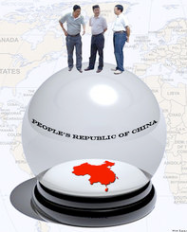For some reason, I never thought I’d have to Google “what to do for venomous centipede bites.” Unfortunately, when you’re living in southern China, you end up searching for a lot of unusual requests online.
Also unfortunately, a lot of information on these enormous centipedes – scolopendra subspinipes or any of its Southeast Asian variants, including the Chinese red-headed centipede – is not available in English. Thus I found myself in something of a quandary last summer, one evening around midnight, when after dinner out (read: a meal consisting more of báijiǔ than actual shíwù) I felt a pair of tiny forcipules sink deep into my left foot.

A relative of the Chinese Red-Head, the Vietnamese Centipede. Frankly, I’d rather not have either one anywhere near me. (Image courtesy of http://animal-world.com.)
Though I won’t repeat on here what was yelled loudly and emphatically at the time, I’d had previous encounters with the Chinese red-head (Scolopendra subspinipes mutilans). Living on the ground floor of the school’s dorms, the bottoms of our doors were katy-barred with small planks of wood so as to keep out large centipedes, insects, assorted beasties, and what-have-you. Earlier that summer, we’d even seen one of the seven-inch centipedes in question – trapped by some quick-thinking cafeteria workers down the row in an emptied jug of cheap Chinese booze.
(At the time, I felt sorry for the poor bottled creature, and had attempted to let it free. I was subsequently snapped at for letting a poisonous insect back into the school grounds. Where I come from, insects are not inherently life-threatening.)
Following a little online research borne out of curiosity, I learned that bites from these giant scolopendridae could be devastatingly painful – and occasionally deadly, should one be so unfortunate as to get envenomed on the head.

OH GOD! OH WHY! Here it comes, full-speed. Not only are they fast, they’re hyper-perceptive of their surroundings. (Image courtesy of http://bit.ly/XrtyWQ.)
“Shit! These things are running around the dorms,” I remember thinking at the time, still luxuriating in the myriad of large, varied, and exotic insects China had to offer, “and I tried to free one.” I felt horribly guilty, having potentially put a fellow Yongzhou No. 4 High School worker at harm.
But karma works in weird ways. Sitting at my computer that fateful eve, blasting music (as per usual), my involuntary pet centipede decided that hiding under my computer desk no longer constituted acceptable lodging. Chomping into my left metatarsals, my ill-fated, six-inch, hundred-legged friend made a break for it…and I went straight into Full-On Panic Mode, watching a terrified, writhing creature detach itself from my skin and run for the proverbial hills.
Let’s pause here to really drink in that image.
Fellow expats can attest that there’s a moment – in a country where you can’t speak the language, read the signs, or recognize the venomous prehistoric bugs – that you reach something of an enlightened Zen state when worst comes to worst. As venom coursed through my panicked, Western-medicined veins, I entertained the thought that maybe it wouldn’t be that bad.
Yet as the pain set in, I was out for blood (or whatever fluids circulate in the “centipedoidal anatomy”). Because HOLY CHRIST DOES THAT SMART. I found the little fucker making his way underneath my unused fridge, and spent the next 20 minutes smashing it into bite-size, normal-leg-numbered segments. It really did take 20 minutes, as the mutilans subspecies seems to have a unique ability to zombify/Lazarus itself.

This person is a dumb-ass. Case closed. Do not consider anything with fangs your “friend,” even as a baby. (Image courtesy of http://bit.ly/YKwX40.)
While our school’s Foreign Affairs Officer called an ambulance at the ripe hour of 1 a.m., I hobbled the half mile to the front gate and waited with immense trepidation. (“You need an ambulance!” said the FAO, over the phone. “I can’t speak Chinese,” I replied, rolling my eyes inaudibly. “Oh. Maybe I will call for you.” Wait, maybe?!)
When the good folks online say the bite may incur:
- “‘Rippling pain” (mine lasted throughout the left leg for some 18 hours, though some say it may take 2-3 days for the pain to fade);
- “Redness” (oh, and will it be beet-red);
- “Focalized inflammation” (roughly a week after the initial bite, the numerous muscles in my foot became infected and swelled it to the size of a pomelo, requiring additional Traditional Chinese Medicine [TCM] snake-bite pills to reduce the inflammation and necrotized tissue);
- “Abnormal skin tingling, tickling, itching, or burning sensations” (okay, mostly just a lot of itcthing);
- “Acute itching” (but seriously, the itchiness); and,
- “A non-amplifying localized death of living cells” (spoiler alert: the top of my left foot turned black for about a week)
…they aren’t kidding. About a month after the whole ordeal of bite, followed by inflammation, followed by awkward daily outpatient treatment for post-bite inflammation, followed by PTSD-esque nightmares involving squiggly creatures, I came to understand quite well why the cafeteria ladies down the row had entrapped their snaky intruder as they did.

The Crimson Centipede of comic lore, the losing gladiator, and my very red foot, post-fanging. I keep hoping for a Spiderman-like transformation.
The incident also helped me realize, though, the role Traditional Chinese Medicine (TCM) still plays in modern-day China, and why Western medicine will never fully monopolize the vast Chinese pharmaceuticals market. After all, if it weren’t for the magical snake-bite pills the doctor in Yongzhou prescribed me, I may well have left China without a left foot. A mere “10 pills, three times a day,”and I was bouncing back.
(That’s not to say the green, globulous TCM mass they spread on my back to “reduce fever” is as effective as, say, taking a bunch of Tylenol. It has its time and place. As do centipede bites.)
And yet, a few months later, I never thought I’d have to Google “what to do for appendicitis.” But when you’re living in southern China, you end up searching for a lot of unusual requests online. In the age of a fast-developing Middle Kingdom, though, where East increasingly meets West, you end up with a lot of interesting stories to tell later on.












